A Quantitative Study on the Distribution of Mitochondria in the Neuropil of the Juvenile Rat Somatosensory Cortex
- PMID: 30060007
- PMCID: PMC6132283
- DOI: 10.1093/cercor/bhy159
A Quantitative Study on the Distribution of Mitochondria in the Neuropil of the Juvenile Rat Somatosensory Cortex
Abstract
Mitochondria play a key role in energy production and calcium buffering, among many other functions. They provide most of the energy required by neurons, and they are transported along axons and dendrites to the regions of higher energy demands. We have used focused ion beam milling and scanning electron microscopy (FIB/SEM) to obtain stacks of serial sections from the somatosensory cortex of the juvenile rat. We have estimated the volume fraction occupied by mitochondria and their distribution between dendritic, axonal, and nonsynaptic processes. The volume fraction of mitochondria increased from layer I (4.59%) to reach its maximum in layer IV (7.74%) and decreased to its minimum in layer VI (4.03%). On average, 44% of mitochondrial volume was located in dendrites, 15% in axons and 41% in nonsynaptic elements. Given that dendrites, axons, and nonsynaptic elements occupied 38%, 23%, and 39% of the neuropil, respectively, it can be concluded that dendrites are proportionally richer in mitochondria with respect to axons, supporting the notion that most energy consumption takes place at the postsynaptic side. We also found a positive correlation between the volume fraction of mitochondria located in neuronal processes and the density of synapses.
Figures
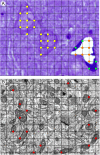


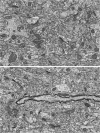
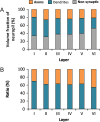
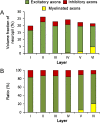
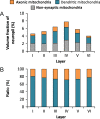
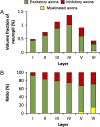


Similar articles
-
Volume electron microscopy of the distribution of synapses in the neuropil of the juvenile rat somatosensory cortex.Brain Struct Funct. 2018 Jan;223(1):77-90. doi: 10.1007/s00429-017-1470-7. Epub 2017 Jul 18. Brain Struct Funct. 2018. PMID: 28721455 Free PMC article.
-
Size, Shape, and Distribution of Multivesicular Bodies in the Juvenile Rat Somatosensory Cortex: A 3D Electron Microscopy Study.Cereb Cortex. 2020 Mar 14;30(3):1887-1901. doi: 10.1093/cercor/bhz211. Cereb Cortex. 2020. PMID: 31665237 Free PMC article.
-
The effects of aging on neuropil structure in mouse somatosensory cortex-A 3D electron microscopy analysis of layer 1.PLoS One. 2018 Jul 2;13(7):e0198131. doi: 10.1371/journal.pone.0198131. eCollection 2018. PLoS One. 2018. PMID: 29966021 Free PMC article.
-
[Nonsynaptic interneuronal contacts in the cerebral cortex].Arkh Anat Gistol Embriol. 1983 Oct;85(10):5-16. Arkh Anat Gistol Embriol. 1983. PMID: 6318703 Review. Russian. No abstract available.
-
Crosstalk of Local Translation and Mitochondria: Powering Plasticity in Axons and Dendrites.Neuron. 2019 Jan 16;101(2):204-206. doi: 10.1016/j.neuron.2018.12.027. Neuron. 2019. PMID: 30653934 Review.
Cited by
-
Real-time tracking of brain oxygen gradients and blood flow during functional activation.Neurophotonics. 2022 Oct;9(4):045006. doi: 10.1117/1.NPh.9.4.045006. Epub 2022 Nov 28. Neurophotonics. 2022. PMID: 36457848 Free PMC article.
-
Lipopolysaccharide induces human olfactory ensheathing glial apoptosis by promoting mitochondrial dysfunction and activating the JNK-Bnip3-Bax pathway.Cell Stress Chaperones. 2019 Jan;24(1):91-104. doi: 10.1007/s12192-018-0945-7. Epub 2018 Oct 29. Cell Stress Chaperones. 2019. PMID: 30374881 Free PMC article.
-
Glutamatergic Dysfunction and Synaptic Ultrastructural Alterations in Schizophrenia and Autism Spectrum Disorder: Evidence from Human and Rodent Studies.Int J Mol Sci. 2020 Dec 23;22(1):59. doi: 10.3390/ijms22010059. Int J Mol Sci. 2020. PMID: 33374598 Free PMC article. Review.
-
How expensive is the astrocyte?J Cereb Blood Flow Metab. 2022 May;42(5):738-745. doi: 10.1177/0271678X221077343. Epub 2022 Jan 26. J Cereb Blood Flow Metab. 2022. PMID: 35080185 Free PMC article.
-
Axonal energy metabolism, and the effects in aging and neurodegenerative diseases.Mol Neurodegener. 2023 Jul 20;18(1):49. doi: 10.1186/s13024-023-00634-3. Mol Neurodegener. 2023. PMID: 37475056 Free PMC article. Review.
References
Publication types
MeSH terms
LinkOut - more resources
Full Text Sources
Other Literature Sources

